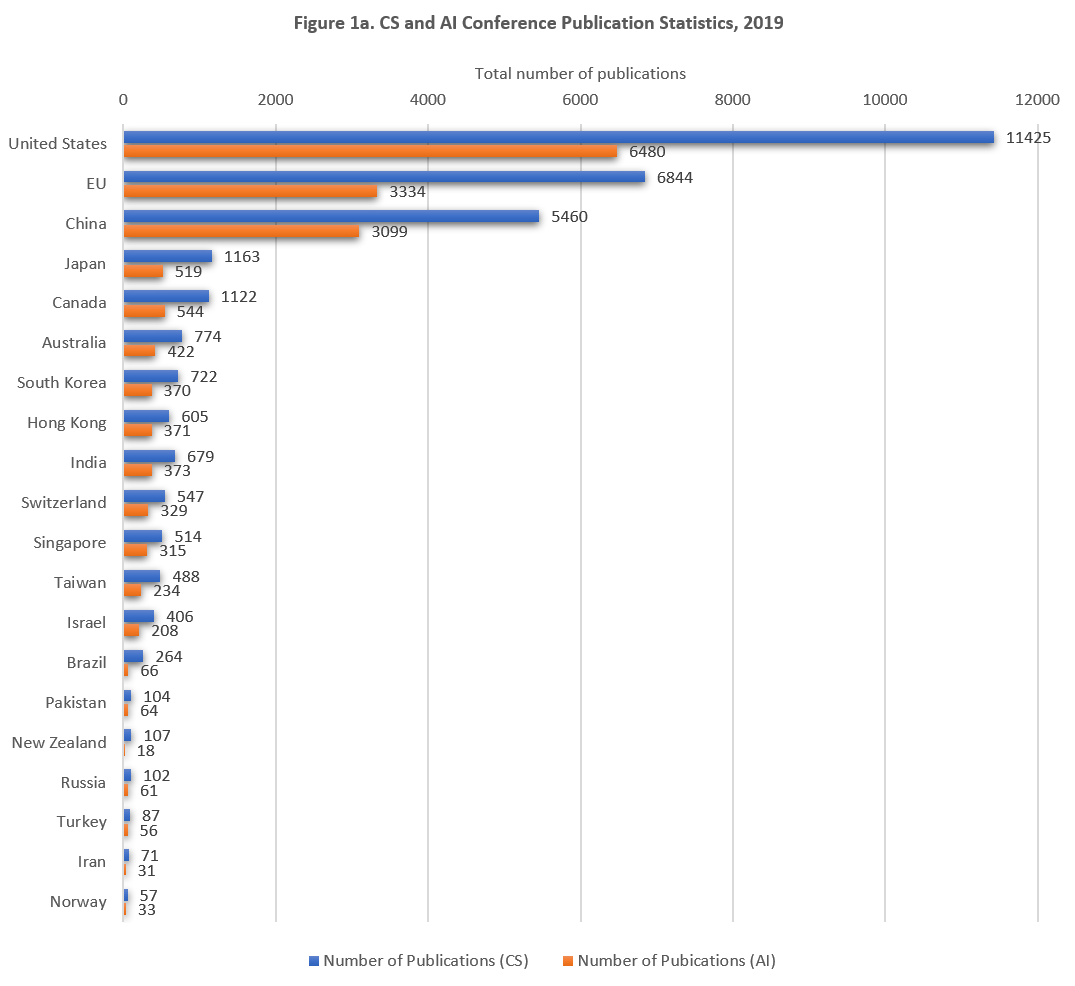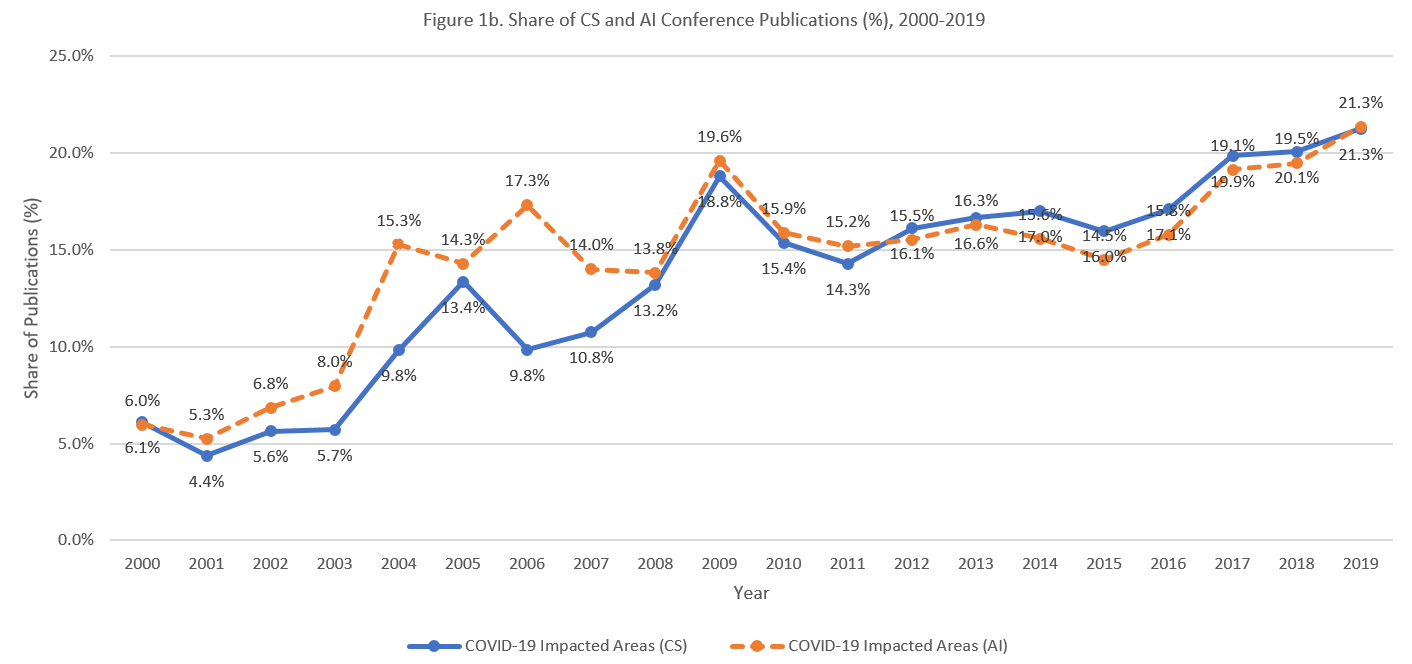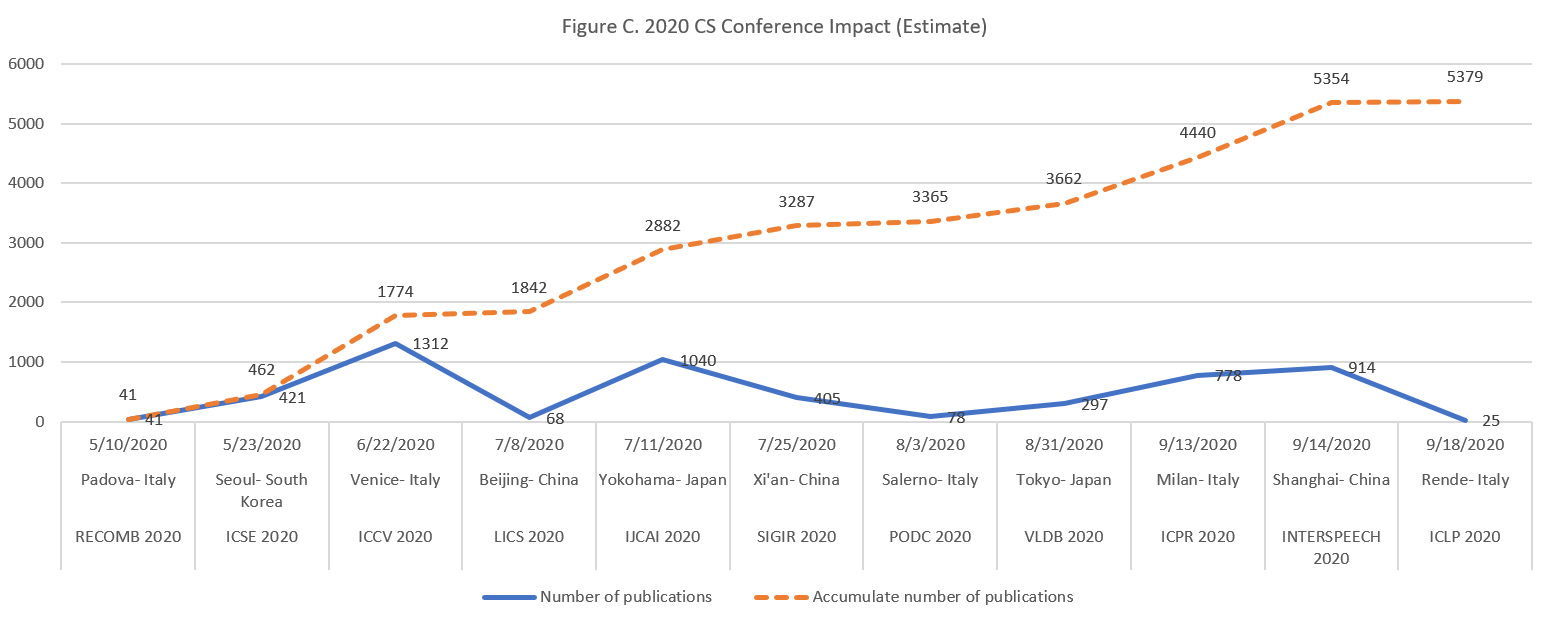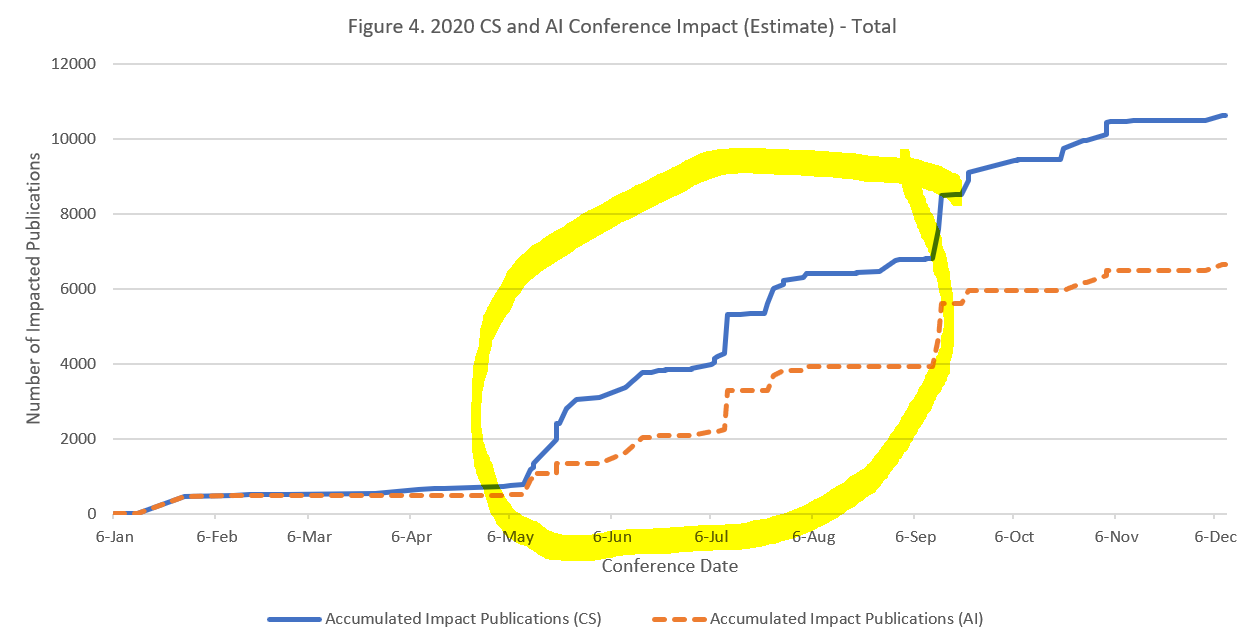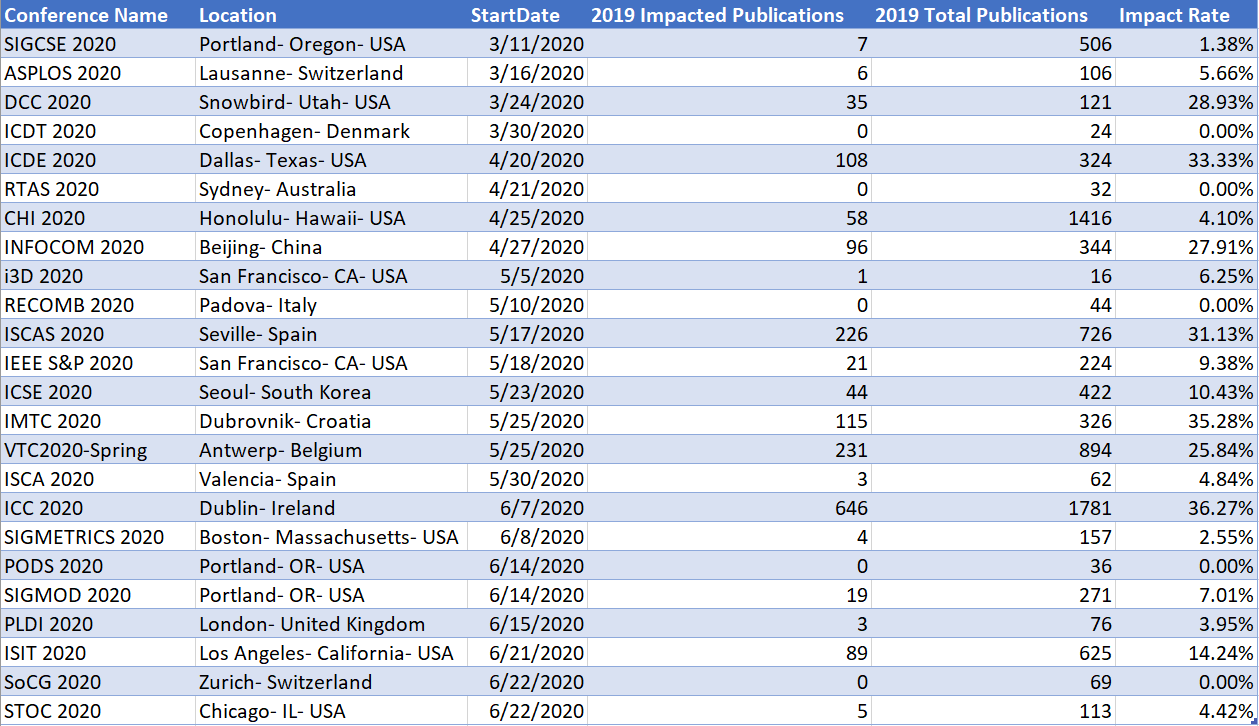By March 10th, 2020 the novel coronavirus (COVID-19) has infected ~117k and been responsible for the deaths of over 4k people worldwide. The World Health Organization (WHO) has not yet classified the COVID-19 outbreak as a pandemic, however, COVID-19 has resulted in a significant impact on individual lives and global economics. Following the Microsoft Academic team’s goal to “help researchers stay on top of their game”, we are providing an analysis of the COVID-19 impact on the computer science (CS) research community to help enable conference organizers and institutions to respond accordingly and manage the impact.
Our analysis shows that:
- There is increasing author participation in both CS and AI conferences from the COVID-19 impacted regions in the past ten years, from about 6% to over 20% in 2019.
- The disease could impact one-fifth of conference attendees in both AI and CS (21.3%).
- May to early September is the period most CS conferences occur, controlling COVID-19 by May will help to reduce the impact in CS research to a minimum.
Background
- As of this article date, the US Center for Disease Control and Prevention (CDC) has issued a travel warning and alert (opens in new tab) recommending travelers avoid or postpone nonessential travel to areas including: China, South Korea, Iran, Italy and Japan. A handful of airlines have reduced or suspended flights to these areas. Also, some cities have imposed lockdowns to contain the virus.
- On the other hand, CS conference publications rely heavily on authors’ physical presentations during the conference. Since the travel interruption could potentially prevent researchers from attending conferences and thus affecting the publications, this analysis considers the areas above as COVID-19 impacted.
- In computer science, conference publication is often preferred over other publications for its higher visibility, greater impact, and faster turnaround time. The COVID-19 impact is most likely to affect the CS research community through conference publications, hence our focus.
Method
- We have picked the 105 most impactful CS conferences for this analysis. Among these 105 CS conferences, 32 are related to artificial intelligence (AI) and used to analyze the COVID-19 impact on AI research
- Two scenarios are evaluated for impact:
- 2020 conferences being hosting in the impacted areas
- Authors located in the impacted area. Headquarter locations for each authors’ last known affiliation are used to determine their location
- Two indicators are used to estimate the impact:
- The number of publications for each CS conferences in 2019 (2018 if it’s biennial)
- The share of publications from COVID-19 affected areas for the past 10 years
- A publication is considered from the COVID-19 affected areas if the headquarter of the first author’s affiliation is located in those areas. Please find the discussion of this approach in section “How to Determine a Publication is Impacted by COVID-19” below
- All publication data is sourced from the Microsoft Academic Graph (opens in new tab)
Analysis and Discussion
1. CS and AI Conference Publication Statistics
The graph below (Figure 1a) shows the total number of CS and AI conference publications in 2019. Only the top 20 regions are shown here. The US followed by the EU, China, Japan and Canada had the highest volume of published papers among the 105 selected CS conferences as well as in the 32 AI conferences.
The table below shows the number of 2019 publications and percentages for the CDC warning/alert areas. Regions are categorized according to the US CDC travel risk assessment, please refer to the CDC (opens in new tab) for the description of each level. China, Iran, South Korea, Italy, Japan and Hong Kong together contributed 21.25% and 21.33% to CS and AI publications in 2019. This could be the rate of authors who couldn’t attend the conferences in 2020 due to the travel interruption by COVID-19 in these areas.
To further confirm the rate of publications from impacted areas, we gathered data between 2000 and 2019. As shown in Figure 1b, there is clearly an increase in publications from the COVID-19 impacted areas. The impacted publication rate for both CS and AI conferences are above 21% in 2019 and possibly higher in 2020.
2. 2020 CS Conference Publications Impact – by Conference Location
The graph below (Figure 2) shows the estimated impact on 2020 CS conferences hosting in COVID-19 impacted areas. The number of publications from 2019 is used to estimate the number of publications in 2020. The solid blue line shows the accumulated number of impacted publications over time.
3. 2020 CS and AI Conference Publications Impact – by Author Location
The graph below (Figure 3) shows 2020 CS and AI conferences which are hosting outside COVID-19 impacted areas. The numbers of publications for each impacted conference are estimated by the number of publications in 2019 (2018 if it’s biennial) from COVID-19 impacted areas. According to our analysis, among the CS conferences scheduled in the coming four months, ICC, IMTC, ICDE and ISCAS have the most publications contributed from the COVID-19 impacted areas (each above 30%). We listed the conferences in the next four months with the 2019 publication statistics in Appendix 1 at the end. A majority of the AI conferences for the next four months have 10% to 20% impact rate based on 2019 data (Appendix 2).
4. 2020 CS and AI Conference Publications Impact – Total
The graph below (Figure 4) shows the COVID-19 impact estimates in CS and AI conferences combining the impact from both conference location and author location. The impact has a similar pattern in CS and AI conferences. Starting from May 2019, the impact increases considerably as many conferences occur during the summer months (northern meteorological). If COVID-19 can be contained and the travel interruption is lifted before May 2020, the impact on CS conferences should be minimal. On the contrary, if the outbreak situation cannot be improved by September, there could be significant impact to the CS research community.
5. How to Determine if a Publication is Impacted by COVID-19
As mentioned earlier, we consider a publication to be impacted by COVID-19 if the headquarters of the first author’s affiliation is in one of the affected areas.
We choose the first author’s affiliation location instead of all authors because 1) first author normally is the presenter of the paper and 2) it simplifies our analysis while not significantly impacting the result. A previous paper (opens in new tab) pointed out there are 25-fold increases in international collaborations for scientific development. For the CS publications we analyzed, the cross-region collaboration increases from 7.8% to 23.9% in the past 20 years. Although the cross-region rate is high, only 4% of publications have authors from non-impacted regions while first author is located in impacted regions. Therefore, we believe the first author’s location is a good representation of the publication’s locations.
In the case that the first author is associated with multiple affiliations and one affiliation is in affected areas, we count the publication as affected. Only 0.17% of CS publications have first authors associated with multiple affiliations.
Some affiliations could have multiple locations, such as Microsoft. The headquarter location is used in this scenario. And we estimate there are less than 2% such cases.
Conclusion
All the above estimates are based on the the most current information we could obtain using MAG. If the current situation continues, the data shows the potential for significant impact on CS conferences unless conference organizers take actions to mitigate the impact.
Some conference organizers have already taken actions, such as:
- Postpone and change location. INFOCOM 2020, which was originally planned to be in Beijing China in late April, is moving to Toronto Canada in July.
- Create backup plans. The ACM SIGIR Executive Committee is preparing a backup plan for SIGIR 2020 for potential worst case scenarios, e.g. moving from Xi’an China to Toronto Canada if the WHO extend the “Public Health Emergency of International Concern” by the end of April.
- Extend deadlines. The Web Conference 2020 is extending the early bird deadline by four weeks to give attendees more flexibility to plan their trip.
- Enable remote and video presentations. AAAI 2020 enabled authors to present remotely using teleconferencing or by submitting a video presentation.
Additional CS Conference Updates regarding COVID-19
In an effort to help the CS community we will continue to monitor CS conference announcements regarding COVID-19 and provide updates below:
- 2020-03-10: ICLR 2020 (opens in new tab) is working through potential methods to hold a remote conference this year.
Stay healthy and research on!
Appendix 1
2020 March to June, Non-AI CS Conferences.
Appendix 2
2020 March to June, AI Conferences.


